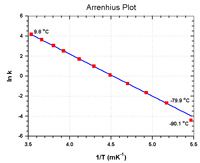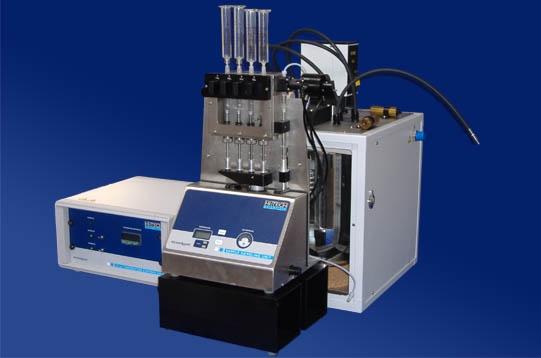Cryo Stopped-Flow Systems
Product Codes: CSF-61DX2 and OPT-658
The original Canterbury stopped-flow was based on a design described in a publication, Caldin, E. F., Crooks, J. E., Queen, A., J. Phys. E: Sci. Instrum. Vol 6, 1973, 930 – 932. This has proven itself to be an enduring design with many instruments sold over a thirty five year history. Indeed, the principle of maintaining the temperature control around the observation cell block and adjacent plumbing, avoiding complications with cooling drive syringes and valves is still apparent in today’s design.
These cryogenic instruments have been the instrument of choice among the inorganic mechanisms community as well as finding favour with the emerging field of bio-inorganic chemistry. With this development, it has become necessary to improve the performance of the instrument; much of this has been as a result of developments with more conventional stopped-flow systems – computerised data acquisition and analysis, diode array (multi-wavelength) detection, and the introduction of more automated, user friendly operation.
This latest generation of instruments bring together the capability of the KinetAsyst range of stopped-flow products with the low temperature sample handling technology specifically engineered for the study of fast reactions down to -90°C.
The sample handling unit provides a means of sample delivery to the low temperature unit from air pressure driven syringes. Single mixing two syringe systems and four syringe double mixing systems are available. The stainless steel enclosure is designed to provide rigidity and resistance to chemical attack. It is important that the plumbing system provides for the total exclusion of air and moisture – in this respect, an option of stainless steel lines or stainless steel/PEEK/Teflon are available. Typically the air driven instrument achieves 2 ms dead times
Utilising the standard KinetAsyst systems high performance electronics and UV/VIS optical platform, it is supplied with a 75W Xenon lamp. The system can operate in single wavelength mode with a photomultiplier or photodiode array mode for the collection of whole UV/VIS spectra (300 – 700 nm). In diode array mode, spectra can be acquired at (typ) 3 ms intervals. The sample cell has a standard 10 mm path length with 1.5 mm available as an option with connection via light guides

The low temperature, Cryo Unit, whose flow lines and mixing chamber are immersed in a thermostating medium, facilitates the control and regulation of temperature using liquid nitrogen fed from a Dewar as a heat sink and a proportional controller with electrical heating to maintain a set point down to -90°C. Additionally, a dip coil (optional) can be included, which can be connected to an external circulator to maintain more moderate temperatures. The sample delivery or sample handling unit is not thermostated.
The instrument is controlled along with data acquisition from the Kinetic Studio software; this is a feature rich application developed specifically for the operation of the stopped-flow systems running on the Windows XP, Vista and Windows 7 platforms. This provides the user with a user friendly and effective facility for the acquisition, processing and analysis of high quality kinetic data.
Selected Publications
- Saouma, C.T., Kaminsky, W., and Mayer, J.M. (2012) Protonation and Concerted Proton-Electron Transfer Reactivity of a Bis-Benzimidazolate Ligated [2Fe-2S] Model for Rieske Clusters. J. Am. Chem. Soc.,134, pp. 7293-7296.
- Gregor, L.C., Rowe, G.T., Rybak-Akimova, E.V. and Caradonna, J.P. (2012) Mechanistic investigation of cyclohexane oxidation by a non-heme iron complex: evidence of product inhibition by UV/vis stopped-flow studies. Dalton Trans.,41, pp. 777-782.
- Ye, W., Staples R.J. and Rybak-Akimova, E.V. (2012) Oxygen atom transfer mediated by an iron(IV)/iron(II) macrocyclic complex containing pyridine and tertiary amine donors. J. of Inorganic Biochemistry,115, October, pp. 1-12.
- Smieja, J. M., Benson, E.E., Kumar, B., Grice, K.A., Seu, C.S., Miller, A.J.M., Mayer, J.M. and Kubiak, C.P. (2012) Kinetic and structural studies, origins of selectivity, and interfacial charge transfer in the artificial photosynthesis of CO. PNAS, September 25,109, no. 39, pp. 15646-15650.
- Huang, D., Makhlynets, O.V., Tan, L.L., Lee, S.C., Rybak-Akimova, E.V. and Holm, R.H. (2011) Kinetics and mechanistic analysis of an extremely rapid carbon dioxide fixation reaction. PNAS, January 25, 2011, vol. 108, 4, pp. 1222-1227.
- van der Westhuizen, H.J., Roodt, A. and Meijboom, R. (2010) Kinetics of thermal decomposition and of the reaction with oxygen, ethene and 1-octene of first generation Grubbs’ catalyst precursor. Polyhedron, 29, Issue 14, 22 September, pp. 2776-2779.
Our Instruments
How can we help you?
Get in touch if you would like more information about any of our instruments or services.
T: +44 (0)1225 868699E: hi-tech@tgkscientific.com Get in touch
